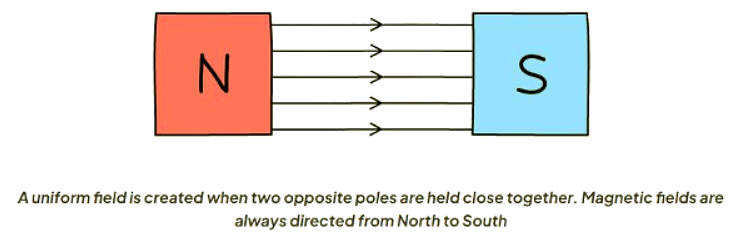Year 11 Exam > Year 11 Notes > Physics for GCSE/IGCSE > Magnetic Fields
Magnetic Fields | Physics for GCSE/IGCSE - Year 11 PDF Download
Magnetic Fields
- All magnets possess a magnetic field around them.
- A magnetic field is described as the area surrounding a magnet where a force acts on another magnet or magnetic materials like iron, steel, cobalt, and nickel.
- To create a uniform magnetic field, align the opposite poles (north and south) of two bar magnets a few centimeters apart.
- This arrangement generates a consistent magnetic field in the gaps between the opposite poles.
- Note that outside this region, the field is not uniform.

- A uniform magnetic field exhibits consistent strength and direction throughout its entirety.
- To demonstrate uniform strength, the magnetic field lines must maintain equal spacing between them.
- To signify consistent direction, each magnetic field line should feature an arrow pointing from the north pole to the south pole.
- Uniformity is indicated by maintaining equal distance between magnetic field lines, even in the gaps between poles, reflecting consistent strength across all points.
- Plotting compasses or iron filings are commonly used to ascertain this field, with compass needles aligning from north to south or iron filings aligning with the field lines.
Magnetic Field Lines
- Magnetic field lines serve to depict both the intensity and orientation of a magnetic field.
- Arrows are employed to indicate the direction of the magnetic field.
- Several guidelines govern the drawing of magnetic field lines:
- They consistently run from north to south, with arrows denoting this direction midway along the line.
- Field lines should never intersect or overlap with other field lines.
Magnetic Field Around a Bar Magnet
- The magnetic field exhibits its greatest strength at the poles, where the magnetic field lines are nearest to each other.
- As the distance from the magnet increases, the magnetic field weakens, attributed to the magnetic field lines becoming more widely spaced apart.
- When drawing magnetic field lines, it is essential to adhere to specific rules to maintain accuracy and consistency:

Magnetic Field Strength
- The intensity of the magnetic field is indicated by the spacing between magnetic field lines:
- Close proximity of field lines signifies a strong magnetic field,
- Whereas widely spaced field lines suggest a weak magnetic field.
- Magnetic forces arise from interactions between magnetic fields, wherein two bar magnets can either repel or attract each other.

- Indeed, the magnetic field lines surrounding various configurations of two bar magnets would appear differently:

Question for Magnetic FieldsTry yourself: What is a magnetic field?View Solution
The document Magnetic Fields | Physics for GCSE/IGCSE - Year 11 is a part of the Year 11 Course Physics for GCSE/IGCSE.
All you need of Year 11 at this link: Year 11
|
127 videos|148 docs|35 tests
|
FAQs on Magnetic Fields - Physics for GCSE/IGCSE - Year 11
| 1. What is the magnetic field strength? |  |
Ans. The magnetic field strength is a measure of the magnetic field's intensity at a certain point in space. It is typically measured in units of teslas (T) or gauss (G).
| 2. How is magnetic field strength different from magnetic field intensity? |  |
Ans. Magnetic field strength refers to the magnetic field's intensity at a specific point, while magnetic field intensity refers to the amount of magnetic force acting on a unit magnetic pole placed in the field.
| 3. How can magnetic field strength be calculated? |  |
Ans. Magnetic field strength can be calculated using the formula H = B / μ, where H is the magnetic field strength, B is the magnetic flux density, and μ is the magnetic permeability of the medium.
| 4. What factors affect the strength of a magnetic field? |  |
Ans. The strength of a magnetic field is influenced by the distance from the magnet, the size and orientation of the magnet, the material the magnet is made of, and any external magnetic fields present.
| 5. Why is understanding magnetic field strength important in various applications? |  |
Ans. Understanding magnetic field strength is crucial in various applications such as electromagnet design, magnetic resonance imaging (MRI) technology, and magnetic levitation systems. It helps in optimizing the efficiency and performance of these systems.
Related Searches






















